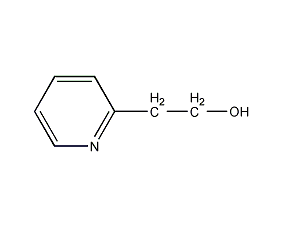
Structural formula
| Business number | 02P5 |
|---|---|
| Molecular formula | C7H9NO |
| Molecular weight | 123.15 |
| label |
2-Ethanolpyridine, 2-Hydroxyethylpyridine, 2-Pyridine ethanol, 2-Ethanolpyridine, 2-(2-Hydroxyethyl)pyridine, Pyridine-2-ethanol, 2-Ethanolpyridine, 2-(b-Hydroxyethyl)pyridine, 2-Pyridineethanol, 2-Pyridylethanol, 2-Pyridin-2-yl-ethanol, 2-(2′-Hydroxyethyl)pyridine, 2-(2-Hydroxyethyl)pyridine, 2-(2-Pyridyl)ethanol |
Numbering system
CAS number:103-74-2
MDL number:MFCD00006364
EINECS number:203-140-2
RTECS number:UT2970450
BRN number:111205
PubChem number:24847871
Physical property data
1. Properties: colorless liquid.
2. Density (g/mL, 20℃): 0.966
3. Relative vapor density (g/mL, air=1): Undetermined
4. Melting point (ºC): -8–7
5. Boiling point (ºC, normal pressure): 169-170
6. Boiling point (ºC, 9mmHg): 114 -116
7. Refractive index: 1.537
8. Flash point (ºC): 57
9. Specific rotation (º): Undetermined
10. Autoignition point or ignition temperature (ºC): Not determined
11. Vapor pressure (mmHg,ºC): Not determined
12. Saturated vapor Pressure (kPa, ºC): Undetermined
13. Heat of combustion (KJ/mol): Undetermined
14. Critical temperature (ºC): Undetermined
15. Critical pressure (KPa): Undetermined
16. Log value of oil-water (octanol/water) distribution coefficient: Undetermined
17. Explosion upper limit (%, V/V): Undetermined
18. Lower explosion limit (%, V/V): Undetermined
19. Solubility: Undetermined
Toxicological data
Acute toxicity: Rat oral LD50: 9500mg/kg; Mouse oral LD50: 7750mg/kg;
Ecological data
Generally speaking, it is not harmful to water.
Molecular structure data
1. Molar refractive index: 35.42
2.Molar volume (cm3/mol): 112.9
3. Isotonic specific volume (90.2K): 294.7
4. Surface tension (dyne/cm) : 46.3
5. Dielectric constant:
6. Dipole moment (10-24cm3):
7. Polarizability: 14.04
Compute chemical data
1. Reference value for hydrophobic parameter calculation (XlogP): None
2. Number of hydrogen bond donors: 1
3. Number of hydrogen bond acceptors: 2
4. Number of rotatable chemical bonds: 2
5. Number of tautomers: 2
6. Topological molecule polar surface area 33.1
7. Number of heavy atoms: 9
8. Surface charge: 0
9. Complexity: 75.3
10. Number of isotope atoms: 0
11. Determine the number of atomic stereocenters: 0
12. Uncertain number of atomic stereocenters: 0
13. Determine the number of chemical bond stereocenters: 0
14. Number of uncertain chemical bond stereocenters: 0
15. Number of covalent bond units: 1
Properties and stability
Avoid contact with strong oxidizing agents.
Storage method
Store in a cool, ventilated warehouse. Keep away from fire, heat sources and anti-static. should be kept away from oxidizer, do not store together. Use explosion-proof lighting and ventilation facilities. It is prohibited to use mechanical equipment and tools that are prone to sparks. The storage area should be equipped with emergency release equipment and suitable containment materials.
Synthesis method
Obtained from the addition reaction of 2-methylpyridine and formaldehyde. Add formaldehyde and 2-methylpyridine into the reaction pot, add nitrogen, stir and heat to 125°C, the pressure is about 0.4MPa, after 20 hours of reaction, carry out vacuum distillation, collect the 130-145°C (2.13kPa) fraction, and get 2-(2-Hydroxyethyl)pyridine.
Purpose
Used in organic synthesis.

 微信扫一扫打赏
微信扫一扫打赏

